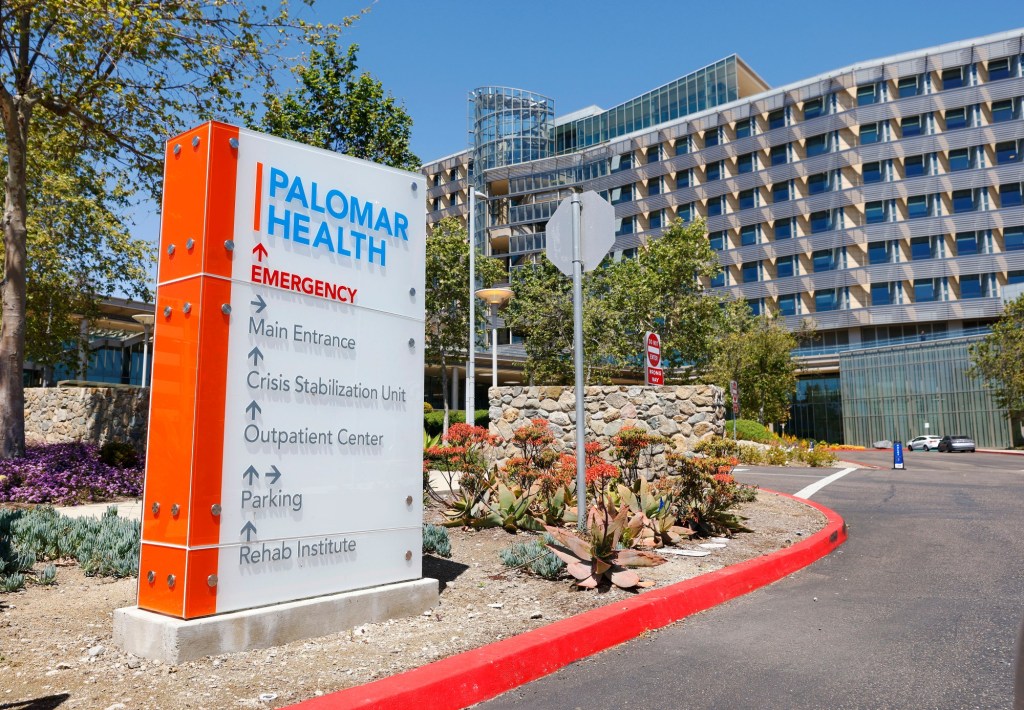

A $165 million operating loss in its previous fiscal year has Palomar Health asking its lenders not to enforce borrowing terms that could push the North County medical provider into bankruptcy.
While such extreme measures seem unlikely, it is clear that investors might ask for operational changes at Palomar in order to improve the bottom line, which could force the state’s largest public hospital district to further cut services. Like many medical providers, Palomar has struggled for several years to maintain a balanced budget in the face of increased wages and supply costs, stagnant revenue and increased competition in a market dominated by large systems with extensive primary care and specialty networks.
Many in the industry are closely following the situation as Palomar is a critical part of the regional health care system, providing a comprehensive range of health care services to the hundreds of thousands of residents living within its boundaries, which cover 800 square miles, stretching east to Julian and north past Pauma Valley to Palomar Mountain.
An October report from Moody’s Ratings, one of the world’s big-three credit rating agencies, noted that Palomar appeared to be about to violate its financial covenants, falling below requirements for cash reserves and available cash flow that would allow lenders to demand immediate repayment of more than $700 million in bonds borrowed against future revenue.
Palomar’s latest financial disclosure shows that it had only about $85 million in cash and sellable investments when its fiscal year ended on June 30 — down from $203 million in its previous fiscal year and $252 million in fiscal 2022 — and the organization has not yet filed a statement for the first quarter of the new fiscal year that started July 1. Payment acceleration, which Moody’s describes as a situation where “all of Palomar’s revenue bond debt could come due,” would likely push the public health care district to seek bankruptcy protections.
But that possibility does not seem likely.
Palomar’s governing board voted on Nov. 26 to allow their chief executive officer, Diane Hansen, to negotiate a forbearance agreement with Assured Guaranty Inc., the insurance company underwriting the bonds.
Craig Kornett, managing director and head of not-for-profit health care investment banking at Ramirez & Co., a New York-based investment bank and investment advisory firm, said that such pacts generally trade concessions from the borrower for the lender’s agreement to set aside the right to immediate repayment.
There is generally little appetite to do anything that might make bankruptcy more likely, given that investors lose money during such an expensive and lengthy process.
“Bankruptcy is always a losing proposition,” Kornett said.
While he is not involved in the Palomar situation, the finance expert, whose career arc includes a decade at Citigroup, said that forbearance agreements are generally about bringing in outside experts to help craft an operating plan that restores profitability.
“The last thing investors want is the facility; they don’t want the keys,” Kornett said. “They don’t want to run the operation, but they do want to protect their investment, and they want to make sure that there are experts involved that can help improve operations.”
But would investors prioritize the bottom line over providing as broad a range of services as possible? How might a forbearance agreement change the nature of the services that patients experience and employees provide?
Here, the details are not yet clear.
A spokesperson for Assured Guaranty confirmed in an email that the firm “is working with Palomar Health regarding a forbearance agreement,” but provided no additional details on the process or potential terms. Palomar likewise said in its own short statement last week that the details are still being negotiated so, at this point, there is no agreement to share.
And it is not as if Palomar has made it to this point without making cuts. On July 1, the organization’s hospitals stopped accepting patients picked up on involuntary mental health holds, citing “a lack of funding.” In 2023, Palomar closed its labor and delivery unit at Palomar Medical Center Poway, consolidating the operation in Escondido, citing a dwindling number of deliveries.
Does a forbearance agreement mean that further cuts are to come in order to bring the bottom line level with investor expectations?
Kornett said that it is not as simple as just cutting the least profitable services to make the numbers look better. Modern managed care contracting, he said, often requires medical providers to offer a broad range of services if they want insurance companies to include them as contracted providers.
“A service may appear to be unprofitable; however, a managed care contract may require the availability of those services for its members,” Kornett said. “In my experience, if services are eliminated, it’s because volumes have materially decreased and similar services are available nearby.”
“Consultants,” he added, “are focused on efficiency and often benchmark indicators relative to peers.”
In addition to the breadth of services that Palomar provides, the public also has a solid cash investment in Palomar Health.
Voters passed Proposition BB in 2004, which authorized the district to sell $496 million in general obligation bonds to build what turned out to be the new Palomar Medical Center Escondido, a state-of-the-art facility that opened in 2012 with a construction cost close to $1 billion. These bonds are paid with a special levy on all property in Palomar’s district.
Palomar borrowed against its future revenue to complete the project and now has large debt service payments stretching far into the future.
Several key developments have recently challenged Palomar’s profitability. Kaiser Permanente opened San Marcos Medical Center in 2023, repatriating some services that it previously contracted with Palomar to provide. And Palomar Medical Group, including its former partner Graybill Medical Group, suffered a multi-month cyberattack in 2024, further pinching already strained revenue.
Palomar executives have also said in previous interviews that plans to increase the number of services offered at its main Escondido campus have been slower to materialize than initially estimated.
And Palomar, like every medical provider in the nation, has struggled with increased labor and supply costs since the COVID-19 pandemic.
Chris Van Gorder, chief executive officer of Scripps Health, said he is pulling for Palomar, as it is a critical part of the local health care infrastructure. The hospital’s trauma center, the only one in inland North County, is a pillar of the regional system that cares for severely injured residents.
“I feel for them over there,” Van Gorder said. “All are interested in what’s going on to our north as the stability of every hospital is a concern these days.”
Scripps itself has not been immune, pulling its most-sought-after medical groups out of participation in Medicare Advantage plans, citing reimbursement levels that do not cover costs, and ending labor and delivery services at its Chula Vista hospital, consolidating those services at Scripps Mercy Hospital San Diego.
Kornett said that violation of bond covenants can also present an opportunity for lenders and their representatives to ask for a change in executive leadership running struggling organizations. But the executive said such requests are rare.
“Bondholders’ sole interest is to make sure there are initiatives, programs, plans in place to improve operations,” Kornett said. “Once an organization gets to this level, they’re indifferent if it’s existing management or not that implements it.”
Asked by email whether it is seeking management changes at Palomar, Assured Guaranty did not reply.
Palomar’s board voted 5-1-1 to seek a forbearance agreement, with members Jeff Griffith, Michael Pacheco, Terry Corrales, Laura Barry and Linda Greer in support, Laurie Edwards-Tate in opposition and John Clark abstaining.
Originally Published:






